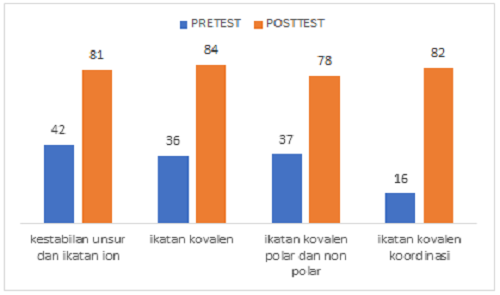
The Problem Based Learning Model in Improving Concept Understanding and Self-Confidence Identification on Chemical Bonds at SMA Negeri 13 Pekanbaru
Abstract
Keywords
Full Text:
PDFReferences
Astika, I. K. U., Suma. I. K., & Suastra, I. W. (2013). Pengaruh Model Pembelajaran Berbasis Masalah terhadap Sikap Ilmiah dan Keterampilan Berpikir Kritis. E-Journal Program Pascasarjana Universitas Pendidikan Ganesha Program Studi IPA. 3(1), 1-10.
Depoter, B. (2007). Quantum Teaching. Mempraktikkan Quantum Learning di Ruang-ruang Kelas. Bandung: Raifa.
Handayani, T, I. D. A. T., Karyasa, I.W., Suardana. I. N (2015). Komparasi Peningkatan Pemahaman Konsep dan Sikap Ilmiah Siswa SMA yang Dibelajarkan Dengan Model Pembelajaran Problem Based Learning dan Project Based Learning. e-Jurnal Program Pascasarjana Universitas Pendidikan Ganesha Program Studi Pendidikan IPA. 5(1), 1-12.
Hesson, M & K. F. Shad (2007). A Student-Centered Learning Model. American Journal of Applied Sciences. 4(9), 628-636.
Istijabatun, S. (2008). Pengaruh Pengetahuan Alam Terhadap Pemahaman Mata Pelajaran Kimia. Jurnal Inovasi Pendidikan Kimia, 2(2), 323-329.
Jahro I. S., & Ridho. D. (2015) Penerapan Model Problem Based Learning Menggunakan Media Exe Learning untuk Meningkatkan Hasil Belajar dan Kerjasama Siswa Pada Materi Hidrokarbon. Jurnal Pendidikan Kimia (JPKIM) 7(3),80-86.
Kusdemir, M., A.Y. Yusuf & C. Tuysuz. (2013). An Analysis of the Effect of Problem Based Learning Model on the 10th Grade Students’ Achievement, Attitude, and Motivation in the Unit of “Mixtures”. Journal of Science and Mathematics Education. 7(2),159-224.
Lidyawati, G. A., & Khaldun, I. (2017). Penerapan Model Problem Based Learning Untuk Meningkatkan Hasil Belajar Dan Keterampilan Berpikir Kritis Peserta Didik Pada Materi Larutan Penyangga. Jurnal Pendidikan Sains Indonesia, 5(1), 140-146.
Lubis, I. R., & Ikhsan. J. (2015). Pengembangan Media Pembelajaran Kimia Berbasis Android Untuk Meningkatkan Motivasi Belajar Dan Prestasi Kognitif Peserta Didik SMA. Jurnal Inovasi Pendidikan IPA 1(2), 191-201.
Nelli, E., Gani. A & Marlina. (2016) Implementasi model Problem Based Learning pada Materi Kelarutan Dan Hasil Kali Kelarutan Untuk Meningkatkan Hasil Belajar dan Sikap Ilmiah Peserta Didik kelas XI SMA Negeri 1 Peudada. Jurnal Pendidikan Sains Indonesia, 4(2), 12-23,
Qianli, T. (2008). The Feasibility of Applying PBL Teaching Method to Surgery Teaching of Chinese Medicine. Journal International Education Studies. 1(4), 110-113.
Rusminiati, N.N., I. Karyasa, W, & Suardana, I. N. (2015). Komparasi Peningkatan Pemahaman Konsep Kimia Dan Keterampilan Berpikir Kritis Siswa Antara Yang Dibelajarkan Dengan Model Pembelajaran Project Based Learning Dan Discovery Learning. e- Journal Program Pascasarjana Universitas Pendidikan Ganesha Program Studi Pendidikan IPA. 5(1), 1-11.
Syahrum & Salim (2012). Metode Penelitian Kuantitatif. Bandung: Cita Pustaka Media.
Wasitohadi. (2014). Hakekat Pendidikan Dalam Perspektif John Dewey Tinjauan Teoritis. Jurnal Satya Widya. 3(1), 49-61.
Wasonowati, R. R. T., Redjeki, T & Ariani, S.R.D. (2014). Penerapan Model Problem Based Learning (PBL) pada Pembelajaran Hukum– Hukum Dasar Kimia Ditinjau dari Aktivitas dan Hasil Belajar Siswa Kelas X IPA SMA Negeri 2 Surakarta Tahun Pelajaran 2013/2014. Jurnal Pendidikan Kimia. 3(3), 66-75.
Zheng, Y. (2013). The Motivation of Problem-Based Teaching and Learning in Translation. Journal of Science and Education. 6(4),120-125.
DOI: http://dx.doi.org/10.31258/jes.5.3.p.409-416
Refbacks
- There are currently no refbacks.
Copyright (c) 2021 Helmy Hidayat Hidayat

This work is licensed under a Creative Commons Attribution 4.0 International License.
Publisher: FKIP Universitas Riau












